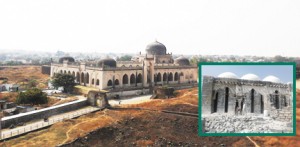While Conservation efforts have failed to protect the Jamia Masjid, the
moat around the Fort is being used as a trash bin of city’s rubble.
By Azmathulla Shariff

It is a case of one arm of the government conserving monuments, while another bent upon reducing them to the trash bin of city’s rubble.
It may be recalled that the Archeological Survey of India undertook major conservation work to save the monuments of Gulbarga in August 2003. As part of the conservation work, major restoration was undertaken on Haft Gumbad at Sangtrashwadi, Shahi Jamia Masjid within the Fort (qila) and the boundary walls of the Fort.
The ASI carried out the work in close collaboration with the then district administration. It removed tones of garbage, rubble and illegal encroachments and gave a massive facelift to the monument. The then deputy commissioner of Gulbarga Anjum Parvez stood by the Archaeological Survey of India as a strong pillar of support. The local Superintendent of Police too chipped in booked the trouble-mongers.
But it seems the current administration is bent upon undoing all the good work. Rubble is being dumped in the moat surrounding the Fort. It is feared that if the moat get filled up by the rubble being brought from the city by truck-loads, the land sharks will not be behind and the entire area may be game for squatters, encroachers and no one knows, even by politicians. The ASI and the then District Administration had planned to clean the moat and fill it with water and make arrangement for boat-ride for visitors.
The locals and the ASI official complain that the moat is being dumped with debris at the behest of local councilors, MLA and goons who enjoy the support of the local politicians. Whenever the ASI staff protest against the dumping of rubble in the moat, the local MLA and councilors bring political pressure to counter the resistance. This is has been going on for years around the Qila, which is a protected national monument. But who cares? The district administration then had planned to shift the encroachers by relocating them elsewhere under the Ashraya Housing Scheme. But all this is story of bygone era. There seems to be no coordination with the district administration at any level in the protection of the national heritage in Gulbarga.
Though the plans to turn the Qila into a tourist spot were grand, it turns out now that the restoration work done a decade ago in the Shahi Jamia Masjid was of inferior quality. The plaster has peeled off from vast chunks of the edifice. Md. Shafi, a mason currently working on the restoration of the 700-year Zanana (women’s) Masjid, says: “the work executed with mortar within and outside the Shahi Jamia Masjid had no strength and has consequently eroded under rains or impact of sun within five years.”
However, it is pointed out that the current conservation in the Zanana Masjid, lying closer to the Shahi Jamia Masjid, is being carried out by the ASI with expert masons requisitioned from Jabalpur. It is being done with the traditional plaster, mortar and stone work. Pramod Singh, a mason from Majholi, says, “While undertaking restoration tasks, expertise should be employed and no compromise should be made in the quality of the material.” Another official feels that the earlier mistakes which have caused extensive damage to the monument cannot be ignored. The department is making use of the black stone obtained from a quarry situated near Herur dam. The quarry is supplying desired size stones from the blast as per requirement. It is time that such mistakes are not repeated.
The chunks of eroded plasters and cracks in walls and domes of the Jamia Masjid bear tell-tale evidence of shoddy work done earlier. It is said that the construction work of the mosque was begun by Sultan Hasan Gangu Bahmani. His successors, Mohammed Shah Bahmani and Feroz Shah Bahmani took it to completion. It has some unique features. The mosque does not require fans or a public address system. The voice of the prayer leader is clearly audible in every corner which puzzles every visitor. The mosque has 240 arches and series of domes, both circular and rectangular. It is said that the chief architect, Mohammed Mahmood Rafee wanted this mosque to be a replica of Grand Mosque in Cordova and invited expertise from Iran and Turkey. The wall depict 150 floral designs, each different from the other.
Incidentally, the muezzin, Mohd Shafeeq Chaoos who is also the caretaker of the mosque for the last 20 years gets a paltry salary of Rs. 650 a month from the Karnataka State Board of Wakfs and the Imam receives Rs. 850.

COMMENTS